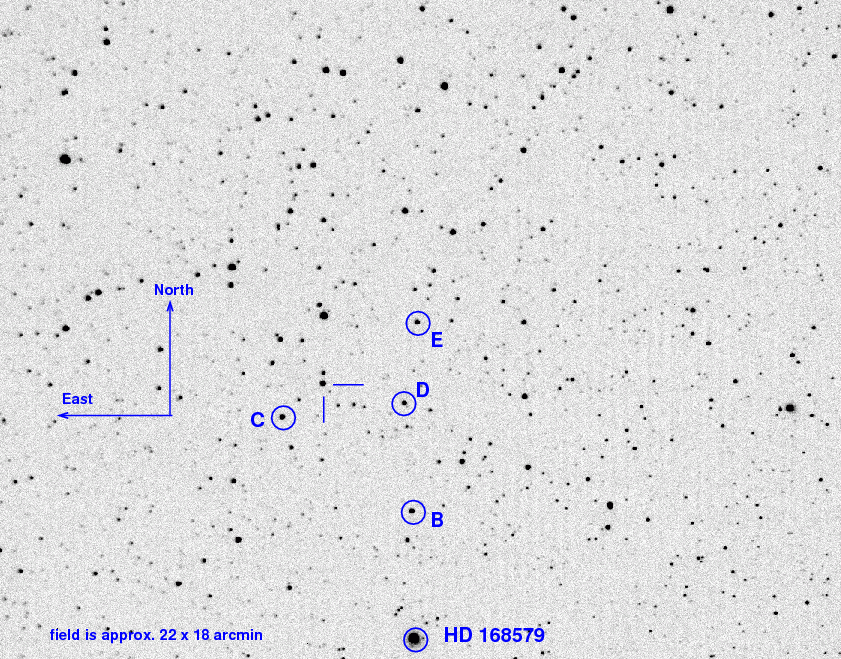
On the night of Mar 23/24, 2018, I acquired a set of observations of the likely black-hole system MAXIJ1820+070, (also known as ASASSN-18ey ). I made measurements over roughly 2 hours at high airmass, with a cadence of about 25 seconds. As you'll see, that's not nearly fast enough to capture the variations in this object.
The main setup was:
Notes from the night:
This optical and X-ray and radio transient is likely a black hole accreting material at a higher-than-usual rate. It has been the subject of many observers over the past two weeks -- see the trail of telegrams that include
The object is located at
RA = 18:20:21.9 Dec = +07:11:07.3
A chart of the field is shown below. The size of the chart is about 22 by 18 arcminutes.
I've marked the location of several comparison stars, which also appear in light curves below. Stars C, D, and E are mentioned by the Tomoe Gozen team in ATel 11426, but all three are rather red, with (B-V) ranging from 1.14 to 1.37. Star B is one of the bluest nearby bright stars, with (B-V) = 0.52.
star UCAC4 B V ---------------------------------------------------- B 486-079513 12.975 12.454 C 486-079608 13.968 12.830 D 486-079523 14.637 13.272 E 487-077858 14.637 13.272 ----------------------------------------------------
Conditions were good, but the target was at high airmass when I started observing. At UT 07:24 = 3:24 AM, the source was at altitude 26.5 degrees = airmass 2.3. I discarded measurements made until UT 07:35 = 3:35 AM, when the target had risen to altitude 28.5 degrees = airmass 2.10. There are subtle but clear signs that stars of different colors vary slowly in relative magnitude as the field rises over the next few hours. The last good measurements occur around UT 10:15 = 6:15 AM, at which point the field appeared at altitude 51 degrees = airmass 1.3.
Image adjustment factor shows the decreasing extinction as the field rose higher in the East, with occasional outliers due to trailed images. There are two gaps in the observations, caused by the observing software reaching the end of a list of 100 requested images. I will be sure to request 999 images in the future.
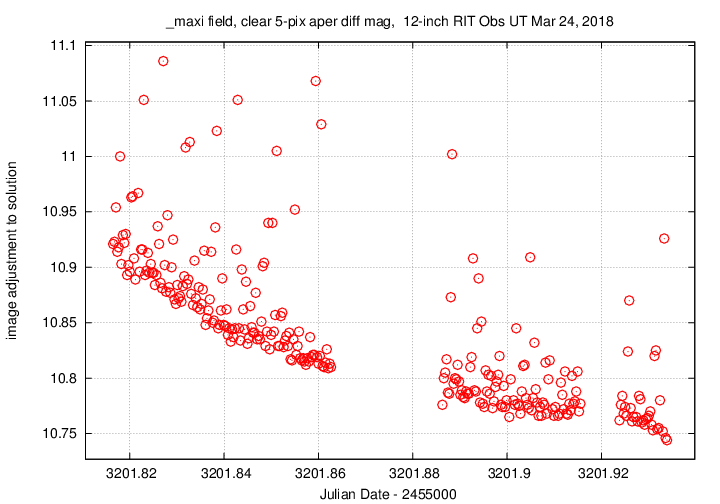
Using aperture photometry with a radius of 5 pixels (radius of 6.6 arcsec), I measured the instrumental magnitudes of a number of reference stars and the target. Following the procedures outlined by Kent Honeycutt's article on inhomogeneous ensemble photometry, I used all stars available in each image to define a reference frame, and measured each star against this frame.
Sigma-vs-mag plots show that the floor was about 0.010 mag. The brightest outlier is a saturated star, and the outlier around instrumental magnitude is MAXI J1820+070.
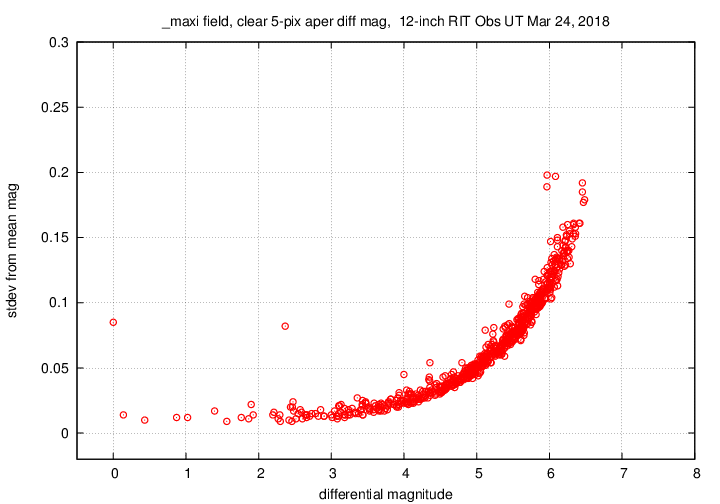
Here are light curves of the variable and the field stars:
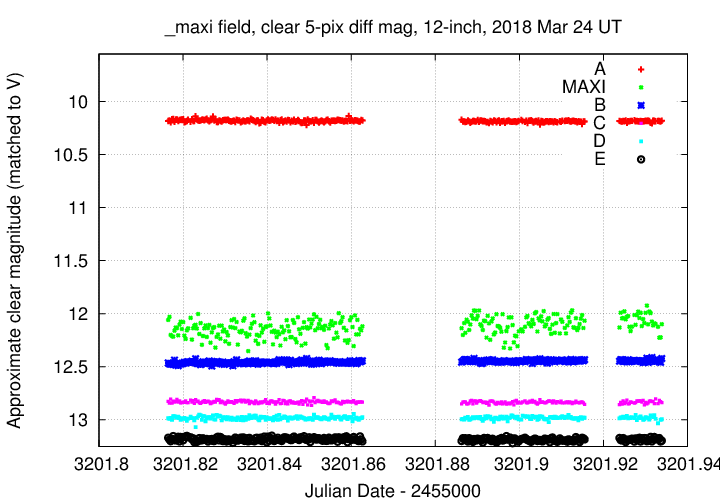
I used the UCAC value for the V-band magnitude of star "B" = UCAC4 486-079513 to shift the ensemble magnitudes to the standard V-band scale -- but remember that these are UNFILTERED measurements.
Here's a closeup on the variable. I'll connect the dots to make its behavior a bit easier to see.
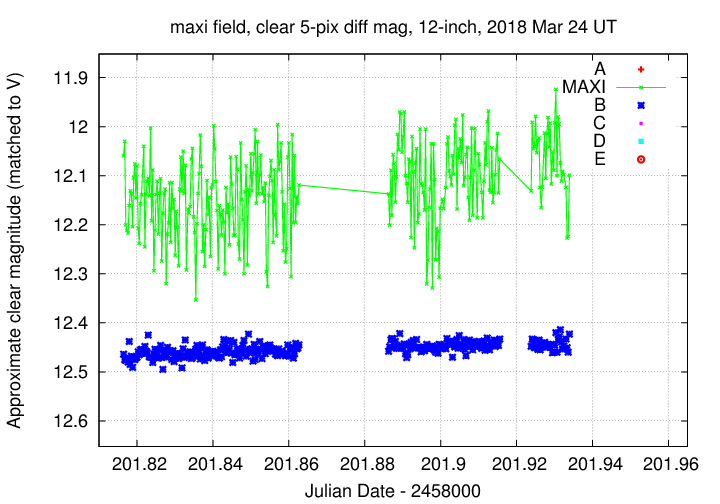
Clearly, I'll need a higher cadence to resolve any of the target's variations -- though of course I can't hope to resolve the sub-second changes which have been observed by others. My plan for the next run will be to read only a sub-section of the entire CCD to decrease the readout time, and reduce the exposure time from 15 seconds to 5 or 8 seconds. I may be able to double the cadence ...
You can download my measurements below. A copy of the header of the file is shown to explain the format.
# Measurements of MAXIJ1820+070 made at RIT Obs, UT 2018 Mar 24, # in good conditions (but high airmass), # by Michael Richmond, # using Meade 12-inch LX200 and ATIK 11000. # Exposures 15 seconds long, no filter. # Tabulated times are midexposure (FITS header time - half exposure length) # and accurate only to +/- 1 second (??). # 'mag' is a differential magnitude based on ensemble photometry # using a circular aperture of radius 5 pix = 6.7 arcseconds. # which has been shifted so UCAC4 486-079513 has mag=12.454 # which is its V-band magnitude according to UCAC4. # # UT_day JD HJD mag uncert Mar24.31647 2458201.81647 2458201.81625 12.059 0.013 Mar24.31677 2458201.81677 2458201.81655 12.030 0.013 Mar24.31706 2458201.81706 2458201.81684 12.200 0.016
Last modified 3/24/2018 by MWR.